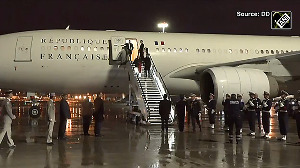Within a month, two more were tested this time on the poor unsuspecting citizens of the Japanese cities Hiroshima and Nagasaki. Five months later, the newly formed United Nations in the very first resolution of the General Assembly declared elimination of WMDs as an essential goal.
At the time the US was the sole nuclear weapon state (NWS) but had no operational nuclear weapons. All the three it had made during the war had been used up. That was the best opportunity the world had to realize the goal set by the nations of the UN.
Towards that end, the United Nations Atomic Energy Commission was set up. All countries were to entrust nuclear materials in their possession to this Commission, which would then serve as a guarantor for supply of these to nations that intended to use them for non-military purposes. With no agreement between the US and the Soviet Union, the plan failed and the Commission was wound up. Over the next 15 years, proliferation in both horizontal and vertical directions was allowed to take place unimpeded.
Eisenhower as President spoke of turning the nuclear swords into ploughshares in his 'Atoms for Peace' speech in 1953, but the soldier in him caused him to declare that nuclear weapons (NW) were no different from conventional weapons. By 1965, US had built up a stockpile of some 30,000 warheads and the Russians had just begun their programme to match the US.
The US rejected the first proposals for a Nuclear Nonproliferation Treaty by Ireland in 1958. Going a step further, influential voices in US expressed readiness to share NW technology with France and other allies. By then, the US had introduced NW in Europe. The Russians had begun assisting the Chinese in developing NW, but later withdrew.
Shortly after, the US spread NW to the Far East by deploying them in Japan and South Korea. Wisely, however, Antarctica was spared by general agreement, and was declared a NW Free Zone, the world's first.
When there were indications in early 1960s that China was getting ready to conduct its first test as the fifth nuclear power state, a view prevailed in some influential circles in US that horizontal proliferation may be acceptable as long as it was limited to helping certain countries to acquire the capability before China. Fortunately, wiser counsel prevailed.
The first effort to examine proliferation seriously, was undertaken by the Presidential Task Force, also known as the Gilpatric Committee, set up by Lyndon Johnson in 1964, soon after the Chinese test. The Committee's report itself remained classified for many years for the reason that it contained references to suggestions to let Germany have control of NATO NW in Europe and to allow Japan, Taiwan and India acquire NW. Luckily, they remained mere suggestions.
The Gilpatric report was the forerunner for the Non-Proliferartion Treaty (NPT) that was adopted in 1968 and for the later developments in the form of Comprehensive Test Ban Treaty (CTBT) and Fissile Material Cut-off Treaty (FMCT).
'FMCT aimed at India more than at Pakistan, Israel'
Despite the Gilpatric report, there was no evidence of a keenness to prevent proliferation. India was rebuffed when it sought security assurances against nuclear threats, in 1967, in return for giving up the nuclear option. Disturbed by the glaringly discriminatory features of the NPT, India declined to be a party to it.
Later, in the eighties, the clandestine Pakistani attempts to develop nuclear weapons with active Chinese assistance were ignored despite mounting evidence for it. So was South Africa until it voluntarily handed over its bombs to IAEA, with the fall of the apartheid rule.
There was tacit approval for the Israeli attack on an Iraqi nuclear reactor based on a presumption that Iraq was trying to develop nuclear capability. Iraq would again get the stick from US later for an effort in that direction. This served to confirm the reported US acquiescence for nuclear arms in the hands of selected countries.
The NPT as framed in 1968 was a rare Treaty with an end date specified for its life. Every five years reviews were to be held and at the end of 25 years, the Parties were to decide whether to extend the Treaty further and if so for what duration. While asking for Non-Nuclear Weapon States (NNWS) to submit to inspection of their programmes, there was no comparable provision to preclude cooperation among NWS.
NPT falling apart, warns non-proliferation expert
Britain is believed to continue to manufacture NW of US design. Earlier, these were tested in US facilities. China's assistance to Pakistan went unheeded and it was Pakistan that was punished with sanctions.
With no provision to bring all NWS into it, the Treaty entered into force without China and France. These became signatories only twenty-two years later. Members of NPT were given a right to withdraw. The title chosen for the treaty implied emphasis on non-proliferation and not elimination of NW. The object of the Treaty was diluted by inclusion of universal and general disarmament besides elimination of NW. There was no provision to amend the Treaty.
The Treaty bore these seeds of failure, as it was rushed through.
Seven reviews of the Treaty have so far taken place. Only two appear to have been somewhat successful. All the rest were marked by inconclusive debates among the Parties that were broadly divided into two camps, one comprising the NWS and their faithful NNWS allies and the other the remaining NNWS.
The first Review in 1975 produced a final report that urged resolute efforts for early and effective implementation of steps towards nuclear disarmament. The five NWS made individual declarations on security assurances in the First Special Session of UN General Assembly (UNGA) on Disarmament in 1978. There is doubt if these assurances are legally binding.
Concern over un-safeguarded facilities in Israel and South Africa as also on armed attacks on nuclear facilities, frustration that negotiations on CTBT had not begun despite repeated calls by the UNGA, calls for unconditional and legally binding security assurances were the major flash points in the Conference in 1985.
The final document featured a call for an early test ban and nuclear arms freeze. There was no final document at the end of the Review in 1990 due to continued dispute about security assurances and the lack of progress on CTBT.
The decision to extend the Treaty indefinitely was taken in the Review conducted in 1995. Principles and objectives for realization of the Treaty aims were outlined but with no final report produced at the end of the Review, they had no value. Testing of nuclear weapons continued even after NPT entered into force in 1970 and by1995 when extension of the Treaty was under discussion, about 400 nuclear tests had been carried out by the NWS. A demand for stopping the tests early was mounted at the 1995 Review Conference and CTBT materialized in 1996.
Two years prior to the next Review held in 2000, both India and Pakistan, neither of them a member of NPT, carried out nuclear tests. Nevertheless, the Review in 2000 appears to have been the most satisfying to many of the parties. Russia had ratified CTBT and the NWS had agreed to several important steps that seemed to brighten the prospects for nuclear disarmament.
Four events that happened subsequent to the 2000 Review have set the clock back.
North Korea's programme to develop NW was discovered. North Korea then withdrew from NPT. Iran admitted to plans for uranium enrichment that were secret until then. A clandestine network established and run by A Q Khan was uncovered that supplied enrichment plants as well as NW designs to various countries. The 9/11 incident has generated fears of acquisition of nuclear weapons by terrorist groups.
For a country with ambitions about playing a greater role in the UN, there was little general interest in India in the NPT Review Conference of 2005 that concluded recently.
Two Indians attended the Conference, both as Pugwash delegates. Indian news media evinced no interest in such an important Conference. None of the 14 NGOs in India working for abolition of nuclear weapons participated.
According to many observers, the Conference was a colourless affair. The US sent only middle level officials. Most of the time was spent in fruitless procedural discussions. Despite three preparatory meetings in the three years prior to the Conference, no agreement could be reached on even the Agenda, until late in the Conference.
The feeling all-round was that the US was desirous of reneging on the significant steps agreed to in 2000 and wanted no reference to be made to them.
Insistence by US to focus on non-proliferation efforts and punitive measures on delinquent States was met by the demand of NNWS, especially Egypt and Iran, for visible progress on nuclear disarmament. With neither side willing to yield, the Conference yielded no result and ended without even a final report.
A number of questions that the Conference ought to have grappled with remain unresolved raising grave doubts about the future of the NPT. No imaginative and workable solutions appear in sight to bring the three non-parties and DPRK into the Treaty. No ideas too for effectively dissuading a State from developing NW and preventing any State from withdrawing.
There are clearly no prospects for a NW free world at the moment.
India a reluctant nuclear power: Sibal
The US seems keen to retain NW. It has identified a number of missions for these and speaks of the need for developing newer devices. Despite its earlier role in establishing the CTBT, it now considers the Treaty as flawed and shows no intention of ratifying it. China too is yet to ratify it.
In any case, CTBT cannot enter into force unless India and Pakistan also sign it. There are reports that NNWS also figure among those identified as potential targets for US nuclear weapons. Discussions on a Treaty to ban production of fissile material are getting nowhere with US unwillingness to subject its facilities for inspection.
A high level Committee of the UN has suggested that all countries should entrust their fissile material stocks to IAEA, which will then act as a guarantor ensuring supplies to those states that need them for peaceful purposes. This is a return to the original proposal made sixty years ago that was a non-starter then and is likely to remain so now.
These, combined with the fact that countries that manage to develop NW, in spite of the apparent hurdles, have been able to get away with their action seems to provide a motivation for acquisition of NW by those which feel insecure.
Sixty years after the world's first atomic explosion, there are no prospects in sight for the elimination of nuclear weapons.
Per contra, there may be more entities that acquire them.
(L V Krishnan is serving in a committee set up by the Atomic Energy Regulatory Board)






 © 2025
© 2025